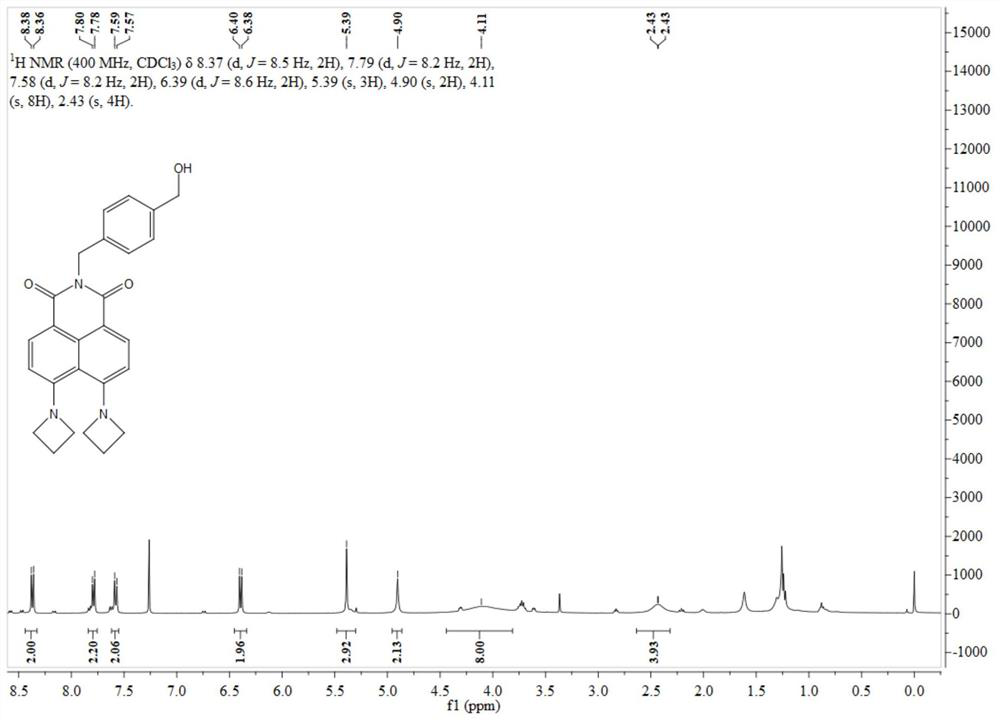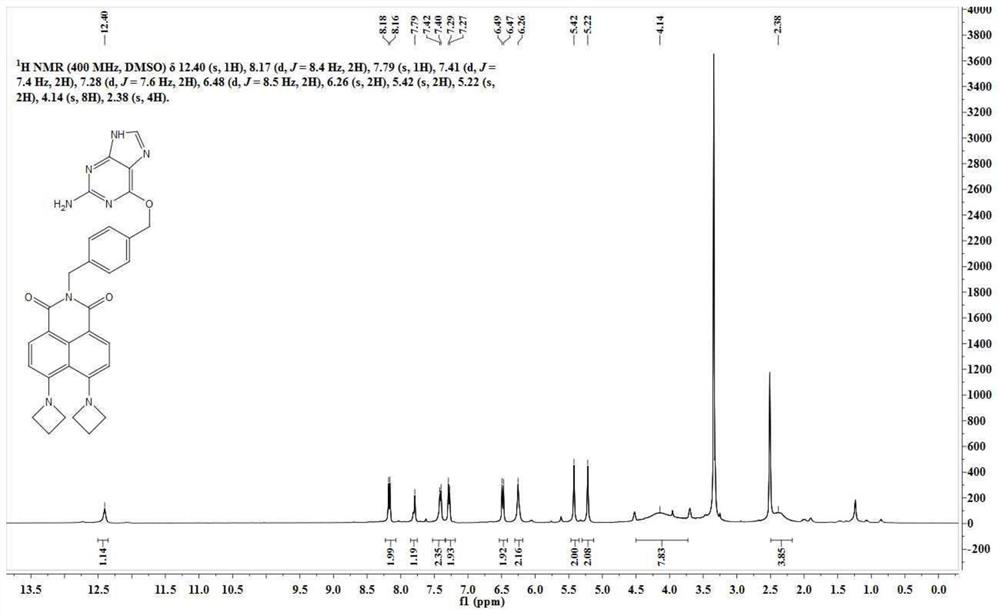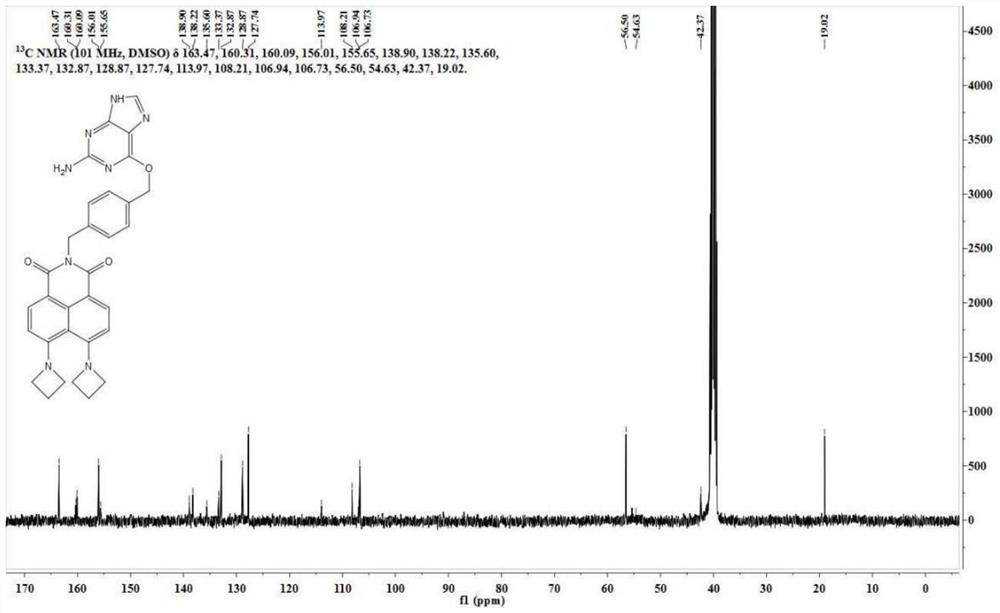A kind of wash-free snap-tag probe excited by 488nm and preparation method thereof
A technology of probes and synthesis methods, applied in the field of protein labeling, can solve the problems of inability to obtain imaging results, increase of false signals, and inability to control the number and position, and achieve the effects of maintaining accuracy, low-cost synthetic materials, and simple and general methods.
- Summary
- Abstract
- Description
- Claims
- Application Information
AI Technical Summary
Problems solved by technology
Method used
Image
Examples
Embodiment 1
[0045] Synthesis of SNAP-DAze:
[0046] Synthesis of intermediate N-(4-hydroxymethyl)benzyl-4-bromo-5-nitro-1,8-naphthalimide (BA-NBr):
[0047]
[0048] 4-Bromo-5-nitro-1,8-naphthalimide (1.00 g, 3.11 mmol) was dissolved in 50 mL of ethanol, and 4-aminomethylbenzyl alcohol (500 mg, 3.60 mmol) was added thereto. After 10 h at 80°C, the solvent was distilled off under reduced pressure, and the residue was separated through a silica gel column (petroleum ether: dichloromethane=3:1-dichloromethane:methanol=200:1, V / V) to obtain 480 mg of off-white solid. Yield 35%. Its nuclear magnetic spectrum hydrogen spectrum data are as follows:
[0049] 1 H NMR (400MHz, DMSO-d 6 )δ8.69(d, J=8.1Hz, 2H), 8.50–8.39(m, 2H), 7.35(d, J=8.1Hz, 2H), 7.25(d, J=7.9Hz, 2H), 5.23( s,2H),5.13(t,J=5.8Hz, 1H),4.45(d,J=5.5Hz,2H).
[0050] Synthesis of BA-DAze
[0051]
[0052] BA-NBr (300 mg, 0.68 mmol) was dissolved in 30 mL of ethylene glycol methyl ether, and 300 mg of azetidine was added th...
Embodiment 2
[0065] Synthesis of SNAP-DAzo
[0066] Synthesis of intermediate N-(4-hydroxymethyl)benzyl-4-bromo-5-nitro-1,8-naphthalimide (BA-NBr):
[0067]
[0068] 4-Bromo-5-nitro-1,8-naphthalimide (1.00 g, 3.11 mmol) was dissolved in 50 mL of ethanol, and 4-aminomethylbenzyl alcohol (2.00 g, 14.4 mmol) was added thereto. After 1 h at 90°C, the solvent was distilled off under reduced pressure, and the residue was separated through a silica gel column (petroleum ether: dichloromethane=3:1-dichloromethane:methanol=200:1, V / V) to obtain 880 mg of off-white solid. Yield 66%.
[0069] Synthesis of intermediate BA-DAzo
[0070]
[0071] BA-NBr (100 mg, 0.23 mmol) was dissolved in 20 mL of ethylene glycol methyl ether, and tetrahydropyrrole 300 mg was added thereto. The reaction solution was slowly heated to 100°C and reacted for 24h. Ethylene glycol methyl ether was removed under reduced pressure, and the residue was separated through a silica gel column (dichloromethane:methanol=80:...
Embodiment 3
[0079] Synthesis of SNAP-DMEDA
[0080] Synthesis of intermediate N-(4-hydroxymethyl)benzyl-4-bromo-5-nitro-1,8-naphthalimide (BA-NBr):
[0081]
[0082] 4-Bromo-5-nitro-1,8-naphthalimide (1.00 g, 3.11 mmol) was dissolved in 80 mL of ethanol, and 4-aminomethylbenzyl alcohol (1.00 g, 7.2 mmol) was added thereto. After 10 h at 40°C, the solvent was distilled off under reduced pressure, and the residue was separated through a silica gel column (petroleum ether: dichloromethane=3:1-dichloromethane:methanol=200:1, V / V) to obtain 573 mg of off-white solid, Yield 43%.
[0083] Synthesis of BA-DMEDA
[0084]
[0085] BA-NBr (150 mg, 0.34 mmol) was dissolved in 10 mL of ethylene glycol methyl ether, and 200 mg of N,N'-dimethylethylenediamine was added thereto. The reaction solution was slowly heated to 100°C and reacted for 24h. Ethylene glycol methyl ether was removed under reduced pressure, and the residue was separated through a silica gel column (dichloromethane:methanol=...
PUM
 Login to View More
Login to View More Abstract
Description
Claims
Application Information
 Login to View More
Login to View More - R&D
- Intellectual Property
- Life Sciences
- Materials
- Tech Scout
- Unparalleled Data Quality
- Higher Quality Content
- 60% Fewer Hallucinations
Browse by: Latest US Patents, China's latest patents, Technical Efficacy Thesaurus, Application Domain, Technology Topic, Popular Technical Reports.
© 2025 PatSnap. All rights reserved.Legal|Privacy policy|Modern Slavery Act Transparency Statement|Sitemap|About US| Contact US: help@patsnap.com



